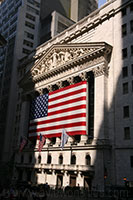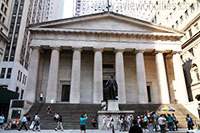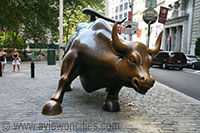Historically known as the center of New York's financial district, Wall Street is often associated with wealth and ambition in America.
How It Got Its Name
After the Dutch  purchased "New Amsterdam" from the Native Americans, a wall was erected that formed the northern boundary of the new colony. That's how Wall Street got its unusual name. The first "walls" along the street were basic plank fences, but as time passed and tensions with the mother country grew, a stronger, taller wall was built in order to defend the colony against both the British and the American Indians tribes that still dominated the area. The British removed the wall around the turn of the 18th century.
purchased "New Amsterdam" from the Native Americans, a wall was erected that formed the northern boundary of the new colony. That's how Wall Street got its unusual name. The first "walls" along the street were basic plank fences, but as time passed and tensions with the mother country grew, a stronger, taller wall was built in order to defend the colony against both the British and the American Indians tribes that still dominated the area. The British removed the wall around the turn of the 18th century.
How It Got Its Reputation
Records show that in the years after the Revolutionary War, traders and

speculators would gather under a particular buttonwood tree that sat at the foot of Wall Street. They soon formed The Buttonwood Association (1792), which is believed to be the roots of the New York Stock Exchange, whose headquarters has been located on Wall Street for centuries.

NYSE
More About Wall Street
By the late 19th and early 20th centuries, Wall Street was "the place" to be if you were a large financial institution or other big business. So many buildings sprung up on this tip of Manhattan that the Wall Street district began to boast its own distinct skyline, separate from the buildings in Midtown.
People like J.P Morgan built headquarters like the one at 23 Wall Street, which was - for decades - the most important financial institution in the country.

(One can still see the pockmarks on the building, left there from an unsolved bombing that occurred in 1920.)
People like J.P Morgan built headquarters like the one at 23 Wall Street, which was - for decades - the most important financial institution in the country.

Federal Hall
Other notable buildings include the columned Federal Hall, originally built to house City Hall and its offices. The New York Stock Exchange (NYSE) Building is also quite grand, built by George B. Post in a neo-classic style that earned it a spot on the National Register of Historic Places. Equally as notable is the ornate 40 Wall Street, once home to the Bank of Manhattan.

Charging Bull
The Charging Bull Statue
One of the Financial District's most famous symbols is the 'Charging Bull' Statue (The bull represents a bull market, a constantly rising market).
Inspired by the stock market crash in 1987, sculptor Arturo Di Modica created the 7,000-pound (3175kg) bull statue as a token of optimism. In 1989 he placed it - without authorisation - in front of the New York Stock Exchange in Wall Street. Police removed the statue but thanks to a public outcry it was reinstalled, but this time on Bowling Green, a small square annex park near Wall Street. The statue has become one of Lower Manhattan's most popular attractions.
Inspired by the stock market crash in 1987, sculptor Arturo Di Modica created the 7,000-pound (3175kg) bull statue as a token of optimism. In 1989 he placed it - without authorisation - in front of the New York Stock Exchange in Wall Street. Police removed the statue but thanks to a public outcry it was reinstalled, but this time on Bowling Green, a small square annex park near Wall Street. The statue has become one of Lower Manhattan's most popular attractions.
Комментариев нет:
Отправить комментарий